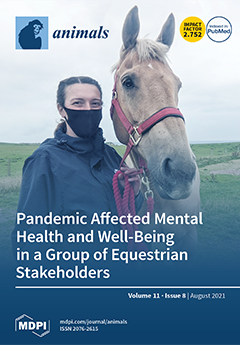The objective of this study was to demonstrate the pharmacokinetic–pharmacodynamic profile, bioavailability, and withdrawal time of tylosin tartrate (TT) administered to olive flounder via intramuscular (IM, 10 or 20 mg/kg,
n = 240) and intravascular (IV, 10 mg/kg,
n = 90) injections. Serum
[...] Read more.
The objective of this study was to demonstrate the pharmacokinetic–pharmacodynamic profile, bioavailability, and withdrawal time of tylosin tartrate (TT) administered to olive flounder via intramuscular (IM, 10 or 20 mg/kg,
n = 240) and intravascular (IV, 10 mg/kg,
n = 90) injections. Serum concentrations of tylosin were determined using a validated liquid chromatography-tandem mass spectrometry method. According to the non-compartmental analysis, the bioavailability of TT was 87%. After the IV injection, the terminal half-life, total body clearance, volume of distribution, and mean residence time of TT were 21.07 h, 0.07 L/kg/h, 2.15 L/kg, and 16.39 h, respectively. Rapid absorption (T
max 0.25 h), prolonged action (terminal half-life, 33.96 and 26.04 h; MRT, 43.66 and 33.09 h), and linear dose–response relationship (AUC
0-inf, 123.55 and 246.05 µg/mL*h) were monitored following 10 and 20 mg/kg IM injection. The withdrawal time of TT from muscle (water temperature, 22 °C) was 9.84 days, rounded up to 10 days (220 degree days). Large C
max/MIC
90, AUC
0-inf/MIC
90, and T > MIC
90 values were obtained for
Streptococcus isolates and these PK/PD indices satisfied the criteria required for efficacy evaluation. This study lays a foundation for the optimal use of TT and provides valuable information for establishing therapeutic regimens.
Full article






